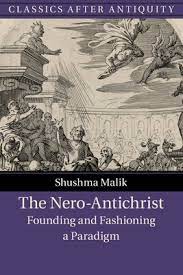The Nero-Antichrist
founding and fashioning a paradigm
- ISBN: 9781108798358
- Editorial: Cambridge University Press
- Fecha de la edición: 2024
- Lugar de la edición: Cambridge . Reino Unido
- Colección: Classics After Antiquity
- Encuadernación: Rústica
- Medidas: 23 cm
- Nº Pág.: 244
- Idiomas: Inglés

It has traditionally been assumed that biblical writers considered Nero to be the Antichrist.. This book refutes that view. Beginning by challenging the assumption that literary representations of Nero as tyrant would have been easily recognisable to those in the eastern Roman empire, where most Christian populations were located, Shushma Malik then deconstructs the associations often identified by scholars between Nero and the Antichrist in the New Testament. Instead, she demonstrates that the Nero-Antichrist paradigm was a product of late antiquity. Using now firmly established traits and themes from classical historiography, late-antique Christians used Nero as a means with which to explore and communicate the nature of the Antichrist. This proved successful, and the paradigm was revived in the nineteenth century in the works of philosophers, theologians, and novelists to inform debates about the era's fin-de-siècle anxieties and religious controversies.
Chapter 1 Introduction: Neronian Myths
Reception Studies and the Bible
Chapter 2 Nero and the Bible
Nero as Antichrist in Biblical Studies
First-Century Perceptions of Nero
Neronian Rome
Nero in the Empire
After Nero's Death: Damnatio Memoriae?
After Nero's Death: The False Neros
Is Nero the Biblical Antichrist?
Daniel
1 and 2 John
2 Thessalonians and Mark's Gospel
Revelation Chapter 3 The Invention of the Nero-Antichrist
Nero as Arch-Persecutor and the Influence of Millennialism
Rejecting Millennialism
Nero as Arch-Destroyer in Pseudepigrapha
The Sibylline Oracles
The Ascension of Isaiah
Educated Elites and Their Audiences
Classical Historiography's Nero as the Anti-Paul
Nero as Anti-Augustus
Nero in Classical Literature
Anti-Augustus and Antichrist
Nero's Death and Late Antiquity
Chapter 4 Reviving the Nero-Antichrist
Ancient Rome and the Nineteenth Century
Greece over Rome?
Imagining Ancient Rome Roman Catholicism in an Atmosphere of Decline
Ernest Renan
Renan's Antichrist-Nero
Renan's Catholicism
Frederic William Farrar
Farrar's Darkness and Dawn
Farrar's Protestantism
Farrar as Historical Novelist
Farrar's Critics
Farrar's Popular Legacy
Oscar Wilde
Wilde's Catholicism
Wilde's Literary Nero
Wilde's Epistolary Nero
Chapter 5 Epilogue: The Legacy of Revival
Sienkiewicz and His Predecessors
The Novel's Nero
Ustinov and His Successors
Appendix A List of Early-Christian References to the Nero






